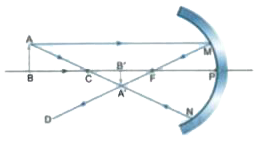A 2.0 cm tall object is placed perpendicular to the principal axis of a concave mirror of focal length 10 cm. The distance of the object from the mirror is 15 cm. Find the nature, position and size of the image formed. Represent the situation with the help of a ray diagram.
Given , f=−10cm,
u= -15 cm ,
h = + 2.0 cm
Using the mirror formula,
1v+1u=1f
1v+1−15=1−10
1v=115−110
∴v=−30.0
The image is formed at a distance of 30 cm in front of the mirror . Negative sign shows that the image formed is real and inverted.
Magnification , m h.h=−vu
h.=h×vu=−2×−30−15
h.=−4cm
Hence , the size of image is 4 cm . Thus, image formed is real, inverted and enlarged.

Topper's Solved these Questions
- LIGHT-REFLECTION AND REFRACTIONBOOK - VK GLOBAL PUBLICATIONCHAPTER - LIGHT-REFLECTION AND REFRACTIONEXERCISE - HOTS (HIGHER ORDER THINKING SKILLS)
23 Videos
- LIGHT-REFLECTION AND REFRACTIONBOOK - VK GLOBAL PUBLICATIONCHAPTER - LIGHT-REFLECTION AND REFRACTIONEXERCISE - SOME IMPORTANT NUMERICALS (FOR PRACTICE)
19 Videos
- LIGHT-REFLECTION AND REFRACTIONBOOK - VK GLOBAL PUBLICATIONCHAPTER - LIGHT-REFLECTION AND REFRACTIONEXERCISE - LONG ANSWER QUESTIONS
3 Videos
- ELECTRICITYBOOK - VK GLOBAL PUBLICATIONCHAPTER - ELECTRICITYEXERCISE - SOME IMPORTANT NUMERICALS
12 Videos
- MAGNETIC EFFECTS OF ELECTRIC CURRENTBOOK - VK GLOBAL PUBLICATIONCHAPTER - MAGNETIC EFFECTS OF ELECTRIC CURRENTEXERCISE - HOTS (Higher Order Thinking Skills)
22 Videos
Similar Questions
A 10 cm tall object is placed perpendicular to the principal axis of a convex lens of focal length 12 cm. The distance of the object from the lens is 18 cm. Find the nature, position and size of the image formed.
View SolutionA 10 cm tall object is placed perpendicular to the principal axis of a convex lens of focal length 12 cm. The distance of the object from the lens is 18 cm. Find the nature, position and size of the image.
View Solution
Knowledge Check
An object of height 5 cm is placed perpendicular to the principal axis of a concave lens of focal length 10 cm. If the distance of the object from the optical centre of the lens is 20 cm. Position, nature and size of the image formed.
A6.67 cm, -1.67 cm, real, invertedB-6.67 cm, 1.67 cm, virtual, erectC-6.67 cm, -1.67 cm, real, erectD-6.67 cm, -1.67 cm, real, invertedAn object is placed at a distance of 20 cm from the pole of a concave mirror of focal length 10 cm. The distance of the image formed is
A+20cmB+10CmC−20cmD−10cmAn object of size 2.0 cm is placed perpendicular to the principal axis of a concave mirror. The distance of the object from the mirror equals the radius of curvature. The size of the image will be
A0.5 cmB1.0 cmC1.5 cmD2.0 cm
A 6 cm tall object is placed perpendicular to the principal axis of a concave mirror of focal length 30 cm. The distance of the object from the mirror is 45 cm. Use mirror formula to determine the position, nature and size of the image formed. Also, draw labelled ray diagram to show the image formation in this case.
View SolutionA 1 cm object is placed perpendicular to the principal axis of a convex mirror of focal length 7.5 cm. Find its distance from the mirror if the image formed is 0.6 cm in size.
View SolutionA 1 cm object is placed perpendicular to the principal axis of a convex mirror of focal length 7.5 cm. Find its distance from the mirror if the image formed is 0.6 cm in size.
View SolutionAn object is placed on the principal axis of concave mirror of focal length 10 cm at a distance of 8.0 cm from the pole. Find the position and the nature of the image.
View SolutionAn object is kept on the principal axis of a concave mirror of focal length 10cm, at a distance of 15 cm from its pole. The image formed by the mirror is:
View Solution
